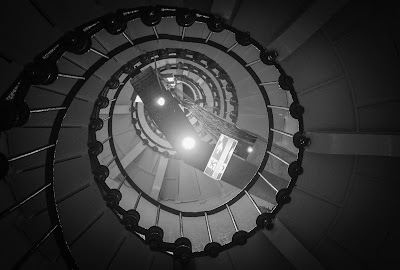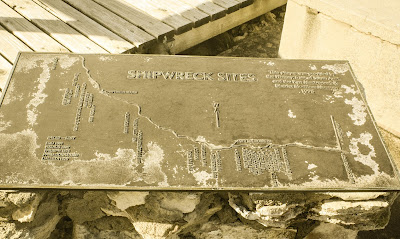We're going on a beer hunt! Actually, we were driving to Adelaide and back via the long and scenic route. I do love a good road trip with Him Outdoors. We began with a drive to Melbourne, stopping only for lunch at Barnawartha for a spot of lunch and a prettily-patterned cappuccino.
 |
| The Joy Bus Cafe, Barnawartha |
The canteen was very busy on a Saturday night with a mix of families and groups, yet we were served quickly and efficiently. The staff were helpful and friendly, asking for our feedback on the beer, which was good, and the mussels, served in a tomato and chili sauce, which were excellent. It's a big business with a comfortable feel, and the large open-barn setting is welcoming rather than intimidating.
 |
| Little Creatures IPA went well with mussels and chips! |
 |
| Inflow and Flood Runner by Tom Rayner |
And so we get to the lighthouses! Actually, there are two in Queenscliff (a black one and a white one), but we didn't visit those as one is in the fort, and only accessible via a tour, which wasn't for several hours, so we gave it a miss.
So, the first lighthouse we visited was at Point Lonsdale at the eastern end of the Bellarine Peninsula. It keeps a watch over The Rip, one of the most notorious entrances to any bay in the world (Port Phillip Bay). Although the light was automated in 1999, this in one of the few lighthouses in Australia that is still staffed 24 hours a day.
An added bonus was that there are tours on Sundays, conducted by the Queenscliff Maritime Museum, so we took one. Being guided up the tower was pretty special, and as we stood in complete calm and stillness while wild winds shrieked and howled outside, we wondered why all tall structures aren't built of this reinforced concrete.
 |
| The staircase inside Point Lonsdale Lighthouse |
Everyone raves about The Great Ocean Road, and there are good reasons why. It is, indeed, stunningly spectacular.
 |
| Angelsea |
Our next stop was Airey's Inlet, where we were greeted by a rather odd one-eyed wooden sculpture. There is no information about it, or the artist, but it has a comically grotesque Odd-Job feeling about it.
The first head lighthouse keeper was George Bardin, who originally came from the Channel Islands. On his voyage to Australia he fell from the crow's nest on board the ship and broke both of his legs. Furthermore, while he was 'recovering' in Williamstown Hospital, rats ate away part of his heels.
 |
| Split Point Lighthouse |
In the 1800s ships bound for the colony of Victoria from Europe took about six months to complete the journey. More than one hundred ships were wrecked on the Victorian Coast, just days before their scheduled arrival in Melbourne.
Ferocious seas, limited navigational aids and sweeping winds added to these maritime disasters. Without having sighted land for so long the ship's navigators were unable to take bearings which would have helped them to determine their position along the Australian coast.
 |
| Eagle Rock |
Of course this sign made us laugh, because we are so childish. We were also amused by the catalogue of things for which one must be prepared along this coast, not least the unexpected wave.
 |
| Beware unexpected waves |
Another nearby sculpture is Buckley's Bunyip by Jeff Raglus. The work is based on the story of William Buckley, an escaped convict, who lived with the Wathaurong people for more than 30 years from 1803.
The sculpture celebrates the story of Buckley who claimed to have seen a bunyip (a large mythical creature from Australian Aboriginal mythology, said to lurk in swamps, billabongs, creeks, riverbeds and waterholes). It also features bird life, insect, weather, myths and history of the wetlands in which the sculpture sits.
Jeff exhibits and sells his timber sculptures locally. He uses three different sized chainsaws to carve the wood before achieving the finer points with Swiss chisels and finally painting the work to highlight features and preserve the timber.
 |
| Buckley's Bunyip by Jeff Raglus |
 |
| Tasting paddle at Rogue Wave Brewery |
 |
| Airey's Pub painting |
 |
| Cape Otway |
This little fellow seemed quite lost and was toddling along the middle of the road. We stopped the car, and other passing traffic, and ushered him off the road and up a nearby tree before proceeding on our way. That felt like our good deed for the day!
The sea stacks along the Great Ocean Road are some of the most spectacular I've ever seen. The lashing rain and pounding surf helps one to understand why there are now only eight of the twelve apostles left. Originally these features were marked on charts as the Sow and Piglets, which would seem to be a less numerically didactic nomenclature.
Most photos depict these geological marvels in sunny weather under blue skies and surrounded by calm water, but I felt the inclement conditions in which we witnessed them added a certain quality that really inspired me.
We finished that day's journey at the marvellous Port Campbell, which we've visited before and which I find a remarkable spot. There's something both reflective and invigorating about the place that feeds my spirit.
 |
| Port Campbell at sunset |
The next day we continued on our journey, but not before going back to the bits we'd missed when it got too dark to see them last night. We went for a blustery invigorating cliff-top walk around Loch Ard Gorge and nearby points. Who needs to exfoliate?
Loch Ard Gorge is named after the clipper ship Loch Ard, which ran aground on nearby Muttonbird Island in June 1878, approaching the end of a three month journey from England to Melbourne. Only two of the 54 people on board survived: 18-year-old Eva Carmichael, one of a family of eight Irish immigrants (the rest of whom perished) and 15-year-old ship's apprentice, Tom Pearce.
An information plaque tells us that after the ship went down,. Tom drifted for hours underneath an upturned lifeboat. When the tide turned at dawn, he was swept, bruised and battered, into the gorge. Shortly after reaching the beach he heard cries from the water and saw Eva clinging to a spar. Tom quickly swam out and struggled for an hour to bring her to the beach. He sheltered her in the cave and revived her with some brandy, which had washed ashore. Then, exhausted, they both slept.
Upon waking Tom climbed out of the gorge to search for help. He came upon two stockmen from nearby Glenample Station. The owner, Hugh Gibson, made immediate arrangements to get Eva out of the gorge and back to the safety of the homestead. While this is a fascinating story in itself, it also raises a number of questions and untold mysteries.
 |
| Loch Ard Gorge |
We continued on to Warnambool, which counts as the Western end of the Great Ocean Road. The Flagstaff Hill Maritime Museum is superb, and is laid out like an 1870s period village with costumed tradesmen and interpreters. The museum features a large collection of items from shipwrecks and highlights several fascinating tales. We have been before (experiencing the excellent sound and laser show Shipwrecked!, which projects images onto water spray and is an innovative way of engaging an audience), so we merely stopped for a few photos before pressing on.
 |
| Warnambool |
 |
| Lady Bay Lighthouse, Warnambool |
Port Fairy is a a charming fishing village, whose wide streets are lined with nineteen-century cottages, great Norfolk pines and old stone churches. Naturally we took a walk to the lighthouse. It was built in 1859 on what was originally Rabbit Island, which later became part of Griffith Island. Because of the south-westerly gales which send huge seas crashing onto the area, the causeway and wall were built to provide safer access.
The island is a nesting site for a colony of shearwater (or muttonbirds). They form their homes in burrows in the sandy ground and, although they fish all day and don't return until dusk, there is evidence of them all along the circuit.
I was actually pretty impressed with the fishing and diving skills of the gannets.
 |
| Whalers Bluff Lighthouse |
Right next to the lighthouse was a clump of trees between the structure and the nearby houses. I thought I saw movement in one of the trees, so I went to investigate and it turned out to be a koala! I'm always surprised to find them, just hanging out and going about their own business (of eating, sleeping and mating).
The lighthouse at Cape Nelson offers spectacular cliff-top views along the coast. The lighthouse was finally lit in 1884 after the building had been delayed by difficulty in obtaining suitable materials. The original bluestone (quarried from close by) soon ran out, and the nearest similar stone was 11km away. As there was no direct road, the stone had to be carted via Portland, 21km distant.
It was howling a gale the day we visited and I think we were well and truly buffeted by the elements. There are refurbished lighthouse keeper's cottages in which you can stay, and a cafe which apparently presents gourmet meals - but all were closed when we were there so we admired the scenery and scuttled back to the car.
The rubble wall surrounding the keepers' quarters and extending out to the light was built to protect the keepers from the harsh winds - it serves its purpose well.
As we crossed the border from Victoria to South Australia we were greeted by the village of Port MacDonnell; brightened with story-telling murals and peculiar statues of penguins.
Cape Northumberland is rocky and remote, and the lighthouse is on private property. The waves and formations of pillars and arches are very dramatic, and a plaque shows the multiple shipwreck sites along that small stretch of coast.
Cape Northumberland is rocky and remote, and the lighthouse is on private property. The waves and formations of pillars and arches are very dramatic, and a plaque shows the multiple shipwreck sites along that small stretch of coast.
Another promontory; another lighthouse. This time the Cape Banks lighthouse above nearby Carpenter Rocks.
 |
| Cape Banks Lighthouse |
 |
| Carpenter Rocks |
 |
| Ash Wednesday |
And back to the lighthouses. Our final one of the day was at Cape Martin. This is a fairly unassuming concrete carbuncle down the end of a windswept cul-de-sac. I guess they can't all look romantically picturesque, as long as they get the job done.
 |
| Cape Martin Lighthouse |
 |
| Cape Martin Lighthouse overlooking Beachport |
 |
| Not chilly at all... |
Beachport also has some murals and curious sculptures for our final cultural fling for the day. The stainless steel sculptures are designed by Andrew Stock and Tony Rosella, representing "all that is important to Beachport: the natural environment; the fishing industry; and the people who live here."







































































































No comments:
Post a Comment